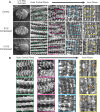Depth and Strain-Dependent Structural Responses of Mouse Lens Fiber Cells During Whole Lens Shape Changes
- PMID: 39976955
- PMCID: PMC11844228
- DOI: 10.1167/iovs.66.2.53
Depth and Strain-Dependent Structural Responses of Mouse Lens Fiber Cells During Whole Lens Shape Changes
Abstract
Purpose: To study the relationship between whole lens shape changes and fiber cell responses to externally applied loads.
Methods: Freshly dissected mouse lenses were compressed by applying glass coverslips to the lens anterior, followed by fixation to preserve lens shape, and preparation for scanning electron microscopy (SEM). SEM images were collected from the outer cortex to the nucleus, and fiber cell end-to-end curvature and membrane paddle dimensions were measured using ImageJ.
Results: At 23% and 29% axial strain, cortical fiber bundle curvature increased significantly compared to control uncompressed lenses, whereas nuclear fiber bundle curvature was unaffected. Outer cortical fiber cell membrane paddles and protrusions were dramatically distorted in a radial direction, with loss of paddle-associated small protrusions in compressed lenses compared to controls, but nuclear fiber cell morphologies were unchanged. The compression-induced increases in cortical fiber cell curvature and distortion of membrane paddles were reversible, with fiber cell morphologies returning to those of control lenses after the release of load.
Conclusions: Whole lens shape changes due to an increase in axial strain result in increased fiber cell curvature and distorted membrane morphologies in cortical but not nuclear fiber cells, indicating that mechanical strain dissipates with depth. The recovery of normal cortical fiber cell curvature and membrane morphologies after the removal of load and lens rounding back to its original shape suggests elastic properties of the young and mature fiber cells and their membrane paddles.
Conflict of interest statement
Disclosure:
Figures






References
-
- Heys KR, Cram SL, Truscott RJ.. Massive increase in the stiffness of the human lens nucleus with age: the basis for presbyopia? Mol Vis. 2004; 10: 956–963. - PubMed
-
- Fisher RF. Elastic properties of the human lens. Exp Eye Res. 1971; 11: 143. - PubMed
-
- Glasser A, Campbell MC.. Presbyopia and the optical changes in the human crystalline lens with age. Vision Res. 1998; 38: 209–229. - PubMed
-
- Glasser A, Campbell MC.. Biometric, optical and physical changes in the isolated human crystalline lens with age in relation to presbyopia. Vision Res. 1999; 39: 1991–2015. - PubMed
MeSH terms
Grants and funding
LinkOut - more resources
Full Text Sources

